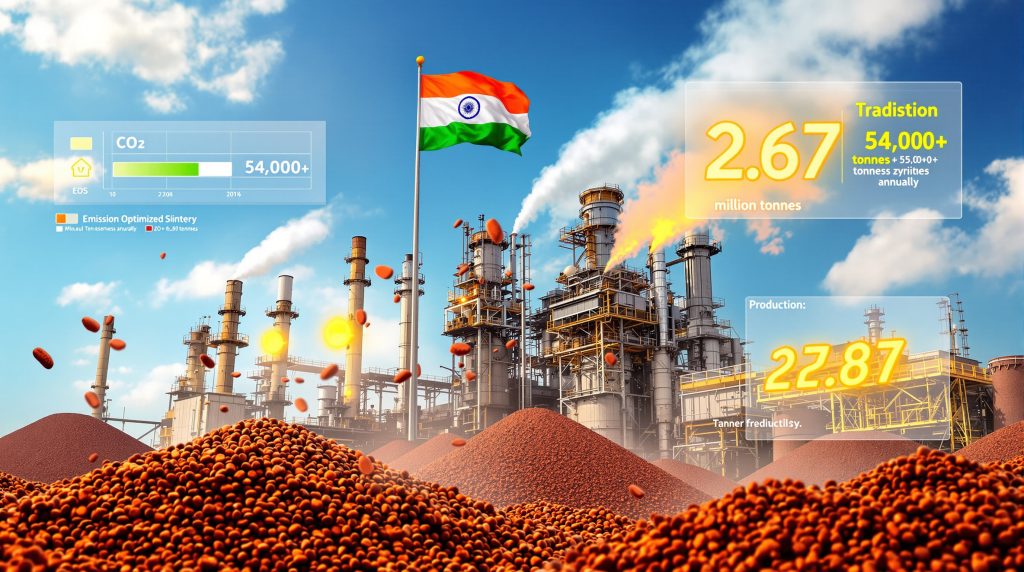Understanding Iron Ore Sintering Technology in Modern Steel Manufacturing
Iron ore sintering represents a critical preparatory stage in steel production, transforming fine iron ore particles into larger, more manageable agglomerates suitable for blast furnace operations. This thermal process involves heating iron ore fines, flux materials, and fuel to temperatures exceeding 1,200°C, creating chemically bonded sinter that improves blast furnace efficiency and reduces energy consumption during steel manufacturing.
Modern sintering plants incorporate sophisticated emission control systems and advanced process optimisation technologies. Metso to deliver iron ore sintering plant to India demonstrates how contemporary facilities integrate environmental sustainability with production efficiency, utilising Emission Optimised Sintering (EOS) technology to achieve substantial fuel consumption reductions while maintaining consistent output quality.
Chemical Reactions and Temperature Management
The sintering process involves complex metallurgical reactions occurring within a temperature gradient across the sinter bed. Iron oxides undergo partial reduction while flux materials form calcium ferrites and silicates that bind the agglomerate structure. Modern EOS technology optimises these reactions through precisely controlled airflow patterns and fuel distribution, enabling more complete combustion and improved heat utilisation efficiency.
Temperature control systems maintain optimal thermal profiles throughout the sinter bed, typically ranging from 1,000°C to 1,400°C depending on raw material composition and target sinter quality specifications. Advanced process control algorithms adjust air volumes and fuel injection rates in real-time, responding to variations in ore chemistry and moisture content.
Steel Production Efficiency Through Advanced Sintering Technology
Contemporary sintering technology directly enhances blast furnace performance through improved raw material consistency and reduced energy requirements. The SAIL IISCO Steel Plant project, incorporating 2.67 million tonnes per year capacity, demonstrates how modern sintering plants support large-scale steel production expansion while achieving environmental compliance objectives.
Quantified Performance Improvements
Advanced sintering systems deliver measurable efficiency gains across multiple operational parameters. Furthermore, the integration of iron ore market trends indicates growing demand for efficient processing technologies:
- Fuel consumption reduction: 15-25% decrease compared to conventional sintering methods
- CO2 emission reduction: Over 54,000 tonnes annually through optimised combustion processes
- Energy efficiency improvement: Enhanced heat recovery and utilisation systems
- Raw material utilisation: Improved iron ore recovery rates and reduced waste generation
These performance metrics reflect the integration of advanced process control systems, optimised air distribution networks, and enhanced fuel injection technologies that characterise modern sintering plant design.
Integration with Blast Furnace Operations
High-quality sinter provides consistent chemical composition and physical properties that optimise blast furnace productivity. Modern sintering plants produce agglomerates with improved reducibility, mechanical strength, and thermal stability, enabling blast furnaces to operate at higher efficiency levels with reduced coke consumption and enhanced iron production rates.
India's Strategic Steel Production Expansion
India's steel sector is experiencing unprecedented growth driven by infrastructure development, urbanisation, and industrial modernisation requirements. The Steel Authority of India Limited (SAIL) has initiated landmark expansion projects totalling 4 million tonnes per annum (MTPA) of additional crude steel capacity, positioning the nation to meet domestic demand while reducing import dependence. In addition, surging iron ore miners are capitalising on this expanded capacity demand.
Market Dynamics and Growth Projections
| Parameter | Current Status | Projected Growth |
|---|---|---|
| Steel Consumption | Rising infrastructure demand | 8-10% annual growth |
| Production Capacity | Major expansion underway | 4 MTPA addition at SAIL ISP |
| Technology Adoption | EOS integration | Advanced emission control |
| Investment Scale | €32 million sintering plant | Multi-billion expansion programme |
Regional steel consumption patterns indicate sustained demand growth through 2030, driven by government infrastructure initiatives, urban development projects, and expanding manufacturing sectors. West Bengal's industrial corridor, anchored by facilities like the Asansol steel complex, represents a strategic geographic concentration of steel production capacity serving eastern and northeastern Indian markets.
Infrastructure Development Impact
Steel demand correlates directly with infrastructure investment levels, including transportation networks, urban construction, and renewable energy installations. India's commitment to carbon emission reduction goals necessitates modern steel production technology that balances capacity expansion with environmental performance requirements.
The integration of advanced sintering technology at major state-owned steel enterprises demonstrates India's commitment to achieving both production growth and sustainability objectives simultaneously.
Emission Optimised Sintering Technology Benefits
Emission Optimised Sintering (EOS) technology represents a significant advancement in sustainable steel production, combining environmental performance with operational efficiency improvements. This technology addresses critical industry challenges including fuel consumption optimisation, emission control, and energy efficiency enhancement.
Environmental Performance Metrics
EOS technology delivers quantifiable environmental benefits through advanced process control and combustion optimisation. However, the broader context of mining industry evolution also influences these technological advances:
CO2 Emission Reduction: More than 54,000 tonnes per year elimination through:
- Enhanced combustion efficiency reducing fuel requirements
- Improved heat recovery systems minimising energy waste
- Optimised air distribution patterns enabling complete fuel utilisation
Fuel Consumption Optimisation: Solid fuel consumption decreases of 15-25% achieved through:
- Precise fuel injection control systems
- Advanced air flow management
- Real-time process monitoring and adjustment capabilities
Technology Implementation and Operational Benefits
Modern EOS systems incorporate sophisticated control algorithms that continuously optimise operating parameters based on raw material characteristics, environmental conditions, and production targets. These systems achieve consistent sinter quality while minimising resource consumption, providing both environmental and economic advantages.
The technology's comprehensive scope includes engineering design, equipment manufacturing, installation supervision, and commissioning support, ensuring optimal performance from initial startup through long-term operations. Integration with existing plant infrastructure requires careful coordination but delivers substantial operational improvements.
International Technology Partnerships in Steel Industry Development
The collaboration between Metso and SAIL exemplifies how international technology partnerships accelerate industrial development while ensuring access to proven, advanced manufacturing systems. This partnership model provides developing steel industries with immediate access to cutting-edge technology without requiring extensive internal research and development investments.
Strategic Partnership Benefits
Long-term technology partnerships deliver multiple advantages. Furthermore, Metso's third iron ore sintering plant delivery to SAIL demonstrates the strength of such collaborations:
Knowledge Transfer: Comprehensive training programmes and technical expertise sharing
Quality Assurance: Proven performance standards and reliability benchmarks
Maintenance Support: Ongoing technical assistance and spare parts availability
Technology Evolution: Access to continuous improvements and upgrades
Risk Mitigation: Established track records reducing implementation uncertainties
Project Implementation Framework
Successful technology partnerships require structured implementation approaches:
- Engineering and Design Phase: Customisation for specific site conditions and requirements
- Manufacturing and Testing: Quality control and performance verification procedures
- Installation and Commissioning: On-site technical supervision and startup support
- Training and Knowledge Transfer: Operational staff development and capability building
The SAIL-Metso partnership spans four successfully delivered sintering plants, demonstrating proven collaboration effectiveness and technology reliability over extended operational periods.
Environmental Compliance and Sustainability in Steel Production
Contemporary steel production faces increasing environmental regulatory requirements and corporate sustainability commitments. Modern sintering technology directly addresses these challenges through measurable emission reductions and resource efficiency improvements, enabling steel producers to meet environmental compliance standards while maintaining competitive production costs.
Regulatory Framework and Compliance Requirements
Steel industry environmental regulations encompass multiple emission categories and resource utilisation standards. Consequently, modern planning & ESG considerations have become integral to project development:
- Carbon dioxide emissions: Mandatory reduction targets and reporting requirements
- Air quality standards: Particulate matter, sulphur compounds, and nitrogen oxides control
- Energy efficiency mandates: Minimum performance standards for major equipment systems
- Resource utilisation optimisation: Waste minimisation and byproduct recovery requirements
EOS technology integration enables steel producers to exceed baseline compliance requirements while establishing operational flexibility for future regulatory changes.
Future Technology Trends in Sustainable Steel Production
Emerging technologies are reshaping steel industry environmental performance. Additionally, decarbonisation in mining presents broader sectoral opportunities:
Hydrogen-based reduction processes: Alternative to coke-based blast furnace operations
Carbon capture and utilisation: Direct CO2 recovery and conversion systems
Renewable energy integration: Solar and wind power for auxiliary plant operations
Circular economy principles: Enhanced byproduct recovery and waste stream utilisation
Modern sintering plants incorporating advanced emission control technologies position steel producers to adapt to evolving environmental requirements while maintaining operational efficiency and cost competitiveness.
Economic Impact of Large-Scale Industrial Projects
Major steel production facility expansions generate substantial regional economic benefits extending beyond direct employment to encompass supply chain development, infrastructure improvements, and tax revenue generation. The €32 million investment in advanced sintering technology at SAIL IISCO represents broader economic development impacts across West Bengal's industrial corridor.
Employment and Skills Development
Large-scale industrial projects create employment opportunities across multiple phases:
Construction Phase Employment:
- Engineering and project management positions
- Specialised equipment installation technicians
- Construction workers and support services
- Local supplier and contractor engagement
Operational Phase Employment:
- Plant operators and maintenance technicians
- Quality control and laboratory personnel
- Administrative and management positions
- Logistics and transportation coordination roles
Regional Development Benefits
Infrastructure Development: Power systems, transportation networks, and utility services expansion
Supply Chain Growth: Local supplier capability development and business opportunity creation
Technology Transfer: Advanced manufacturing skills and technical knowledge dissemination
Economic Multiplier Effects: Increased regional spending and business activity generation
The Asansol, West Bengal location benefits from established industrial infrastructure while contributing to regional economic diversification and growth acceleration.
Technical Specifications and Capacity Planning
Modern sintering plant design requires comprehensive capacity planning that integrates production targets, raw material logistics, environmental performance requirements, and operational efficiency objectives. The 2.67 million tonnes per year capacity specification demonstrates advanced engineering that balances throughput maximisation with resource optimisation and emission control.
Plant Design and Integration Requirements
| Specification Category | Technical Parameters | Performance Targets |
|---|---|---|
| Annual Capacity | 2.67 million tpy | Consistent output reliability |
| Emission Control | 54,000+ tpy CO2 reduction | Environmental compliance |
| Integration Scope | 4 MTPA steel plant expansion | Seamless operational coordination |
| Technology Platform | Emission Optimised Sintering | Advanced process control |
Raw Material Handling Systems: Comprehensive ore blending, flux preparation, and fuel management facilities
Process Control Integration: Real-time monitoring and adjustment capabilities for optimal performance
Environmental Systems: Advanced gas cleaning, heat recovery, and emission monitoring equipment
Construction Timeline and Milestone Planning
Project implementation follows structured phases ensuring systematic development:
2025-2026: Engineering design, equipment manufacturing, and site preparation
2026-2028: Installation, system integration, and preliminary testing
2028-2029: Commissioning, performance optimisation, and operational startup
2029+: Full commercial operation and performance monitoring
The comprehensive scope including engineering, equipment supply, and installation supervision ensures coordinated project execution and optimal performance achievement from initial operation.
Project Management and Technology Integration
Successful large-scale industrial project implementation requires sophisticated coordination across multiple organisational entities, technical disciplines, and regulatory frameworks. The integration of advanced sintering technology within existing steel plant operations demands careful planning and execution to minimise operational disruptions while achieving performance targets.
Risk Management and Quality Assurance
Complex industrial projects incorporate multiple risk mitigation strategies. For instance, global steel industry developments highlight the importance of proven technology implementation:
Technical Risk Mitigation:
- Proven technology platforms with established performance records
- Comprehensive testing and validation procedures
- Experienced international technology partners
- Integrated engineering and manufacturing coordination
Operational Risk Management:
- Detailed commissioning and startup procedures
- Comprehensive operator training programmes
- Maintenance planning and spare parts inventory management
- Performance monitoring and optimisation systems
Stakeholder Coordination and Communication
Multi-organisational projects require structured communication and coordination mechanisms ensuring alignment across engineering teams, equipment manufacturers, construction contractors, regulatory authorities, and operational personnel.
Effective project management incorporates regular milestone reviews, performance assessments, and stakeholder alignment meetings throughout implementation phases, enabling proactive issue identification and resolution.
Future Outlook for Steel Production Technology
The steel industry continues evolving toward enhanced environmental performance, operational efficiency, and resource optimisation through advanced technology adoption and process innovation. Emerging trends indicate accelerating integration of digital technologies, alternative reduction processes, and circular economy principles across global steel production operations.
Technology Development Priorities
Near-term Developments (2025-2030):
- Enhanced emission control systems achieving deeper CO2 reduction levels
- Advanced process automation and artificial intelligence integration
- Improved energy recovery and utilisation efficiency systems
- Enhanced raw material flexibility and quality optimisation capabilities
Long-term Innovation Directions (2030+):
- Hydrogen-based direct reduction technology commercialisation
- Carbon capture, utilisation, and storage system integration
- Renewable energy powered steel production processes
- Fully integrated circular economy material flows
Market Evolution and Competitive Dynamics
Steel producers increasingly compete on environmental performance metrics alongside traditional cost and quality parameters. Companies investing in advanced sintering technology position themselves advantageously for evolving market requirements and regulatory frameworks emphasising sustainability performance.
Furthermore, Metso to deliver iron ore sintering plant to India represents a significant milestone in the country's steel sector modernisation, showcasing how international technology partnerships facilitate rapid industrial advancement while achieving stringent environmental objectives.
The integration of advanced sintering technology represents a strategic investment in both current operational efficiency and future competitive positioning as the steel industry transitions toward sustainable production methods.
Disclaimer: This analysis is based on publicly available information and industry trends. Market projections and technology performance estimates involve uncertainties and should be considered alongside comprehensive technical and financial analysis. Steel production investment decisions require detailed feasibility studies and professional consultation.
Looking to Invest in Advanced Steel Technology Companies?
Discovery Alert's proprietary Discovery IQ model delivers real-time notifications about significant ASX mineral discoveries, including iron ore and steel-related commodities, instantly empowering subscribers to identify actionable opportunities ahead of the broader market. Begin your 30-day free trial today and explore how major mineral discoveries can generate substantial returns by accessing Discovery Alert's comprehensive discoveries showcase.




